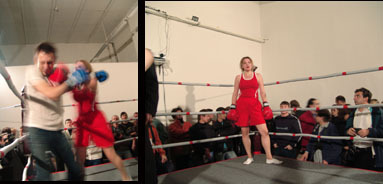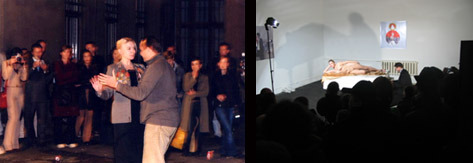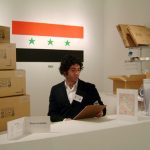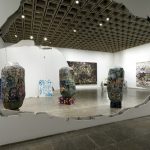The Business of Art: A Conversation with Elena Kovylina
Elena Kovylina is a Moscow-based artist whose confrontational performances concern the political significance of a woman’s experience in Russia today.
Taking on the varied roles of author, aggressor, and object of desire, Kovylina’s devastating and visceral social critiques have made her among the most prominent young artists currently working in Russia.
Her signature piece—the only one thus far seen in the US—is Waltz, a 2001 performance in Berlin that was documented on video and shown in the exhibition Russia Redux #1 at the New York gallery Schroeder Romero in September and October of 2005 and was performed by the artist this past December at the NADA art fair in Miami. In Waltz, spectators are invited to dance with the artist, who is otherwise engaged in a strange ritual of decorating herself with military badges, downing shots of vodka, and smashing the empty glasses on the ground, all the while becoming precariously smashed herself. The audience’s role gradually shifts; whereas at the beginning of the performance Kovylina offers them a pleasant dance, by the end of the piece they’re confronted with having to support the slumping, wobbling, nearly incapacitated artist.
The implication of the audience in a moral game is crucial to Kovylina’s performances. In Boxing, for instance, a 2005 performance executed in Moscow, Kovylina plays the role of macho aggressor, challenging the public to box with her in a ring. Yet in Live Concert, she settles into a passive role, exposing her nude body to the mercy of onlookers. The twin themes of violence and victimization continue in her recent performance Pick Up a Girl which radically reinterprets Yoko Ono’s Cut Piece and imbues it with localisms pertinent to her home country. For this piece, viewers are asked to remove the surgical needles used by the artist to affix magazine images of pin-up girls directly into her body.
Kovylina and New York-based curator and writer Elena Sorokina exchanged several emails and phone calls to compile this, the first interview with the artist to be translated into and published in the English language.
Elena Sorokina: Have you ever studied performance? I know there was no such thing as “performance art studies” in Russia when you were a student. When and how did you get interested in this genre?
Elena Kovylina: I began to look into it in Zurich while a student at the F+F Schule für Kunst und Mediendesign, after a rather difficult process of separation from painting. When I first met with a Swiss art professor I brought 50 of my paintings, all solid socialist-impressionist works; some nudes, some portraits. He said, surprised, “My grandparents painted this way.” I was pretty shocked. “Do you know who Joseph Beuys is?” he asked me. I didn’t. So I asked back, “Do you know who Vasily Surikov is?” He didn’t.
My art education was a classical Soviet one; an art school for children followed by the “Memory of 1905” high school for visual arts and the Surikov Art Institute. Which means I had 13 years of training as an academic painter—boring exercises in drawing nude workers and executing colorful landscapes. Performance as medium struck me with its versatility, its ability to react quickly to social contexts and to different situations. It seemed to bring together all my interests: visual arts, film, theater, activism. I thought performance was a perfect art form for the specific local context I was living in—no art institutions, no interest in contemporary art, no “modern” art education whatsoever. Compared to the oppressive academism of that time, the freedom of performance felt euphoric.

ES: …Which must have changed since then.
EK: Sure, by now I am very aware of the existing tradition and I am interested in a part of it, namely in figures such as Arthur Cravan, the dadaist and cultural provocateur of the beginning of the 20th century and the most colorful member of the Barcelona group, or even in the performative aspect of the work of Malevich. You probably know that his White Square was part of a stage setting. His own funeral was organized as a performance, withBlack Square standing next to his coffin. Marina Abramovic’s early work is important to me, as is Yoko Ono’s. In my recent work Pick up a Girl I am clearly referencing Ono’s Cut Piece.However, most of my performances should be read in relation to the concrete socio-political context of today’s Russia, or, even more broadly, the “post-communist condition,” to use Boris Groys’ term. In Pick Up a Girl, for example, the spectator who “picks up a girl,” a cutout from a glossy magazine, is supposed to subsequently discard it, not keep as a “souvenir” like in Ono’s piece. There is another detail—a bouquet of red roses placed next to me—which acts as romantic camouflage to the spectator’s sexist gaze.
ES: What do you mean when you refer to “the context of today’s Russia?”
EK: I am talking about the condition of the post-Soviet individual, and more concretely, about the post-Soviet feminine condition. I have lived between Russia and Germany for a while and have experienced Russia’s “socio-political context” directly, straightforwardly. It starts when you ask for a visa. Being a young, single, traveling woman, don’t even try to imagine a welcoming treatment at the consulate. When you cross the border, guards order all young women off the bus and ask lots of unfriendly questions. The specter of communism became a specter of prostitution; such is the context and I am a part of it. Regardless of education, occupation, or background, the cliché was invisibly present in so many encounters and conversations.
ES: In your performance Waltz you are using these clichés to create a very charged atmosphere. However, you don’t position yourself as a “victim artist.” I would say, rather, that there is a touch of aggression in this performance. You don’t offer clichés for consideration, you throw them into the spectator’s face.

EK: When I conceived Waltz in 2001, I was just coming to Germany to participate in Rebecca Horn’s classes and tried to think about my situation. I guess my generation is the last one that experienced its Otherness in such a strong way. Such shocks of difference are not possible any longer. Moscow looks as “cool” as Berlin or any other global city and every Russian artist knows who Joseph Beuys is. Back then, I questioned myself: who am I in this new world and how am I connected to it? WWII was for me a strong point of reference because of my Soviet education and because of the war’s place in the Soviet collective memory. I had an image of women veterans of the WWII in my mind. They would gather for celebrations in public spaces, as was usual for the 1st of May or other holidays, and I suddenly realized the cultural specificity of this image. Marlene Dietrich’s songs seemed to fit very well into the scenario of the performance. Vodka is the strongest stereotype of Russianness of all, and drinking so much of it is “technically” the most difficult part of the performance for me. Waltz is extremely hard to endure physically. After performing it I need a couple of days to recover. I haven’t performed it much; the last memorable performance was at the Fondation Cartier in Paris on the invitation of Paul Virilio.
ES: I am interested in how you engage with acting and role-playing in your performances. Just to give you an example, Andrea Fraser’s performance method is described as “incorporating appropriation” so that the line between being and acting—between authenticity and imitation—is no longer drawn. There are traces of acting in anyone’s public presence; how important (or not) is acting for you when you perform?
EK: I am trying to minimize acting and maximize the so-called “presence,” which leads us to the notion of reality. I am modeling real situations and constructing specific relations between myself and the spectator within these situations. My work encompasses a director’s and performer’s tasks simultaneously. If we’re talking about role-playing, I prefer to relate the performances to the concept of a play—I see my performances as a specific kind of play: strategic games, like chess. Although once the rules have been set up, I can be a player but I can’t be a winner. It wasn’t until my last performance, Boxing, that I introduced a clear arbitrator. In this performance, a referee differentiates between winners and losers. The spectator can win over the artist, and the opposite is also true.

ES: The terms “winning” and “losing” have a specific history within the so-called radical Moscow Actionism of the ’90s. Some of these actions have been interpreted as an articulation of the shift of paradigms. The post-Communist utopia of global friendships within the glorious network of capitalism was displaced by the conflicted and violent reality–a world divided into winners and losers. How do you relate your work to these artists?
EK: I grew up under the influence of artists such as Avdey Ter-Oganyan, Anatoly Osmolovsky, Alexander Brener, and Oleg Mavromatti—they are tremendously important for my work. Their actions in public spaces were conceived and performed during a very complicated time. Today the domain of art is becoming more autonomous from the political and social domains than it used to be in the ’90s. For the time being, art has defined its territory. I can now work as a performance artist and be recognized as such thanks to the Actionists.
Alexander Brener is particularly interesting to me. He wants to challenge the entire world, to confront it with his critical position, and to live his life as a radical-nihilist project, which results in the rejection of any power or institution. He is holding a position of a marginal intellectual and his situation reflects the fact that a radical gesture has become impossible today. A radical gesture can only exist outside of established institutions or the market. When institutions or a market valorize a work of art, it ceases to be radical.
I do work within the same social context as the Actionists of the ’90s, but in contrast to these artists’ work, my performances are more constructed. They don’t translate “the situation in the country,” the eternal “chaotic transitional period,” they create specific situations between real life and an aesthetic experience.
Elena Sorokina is a New York-based curator and writer. She recently curated the showsRussia Redux #1 at Schroeder Romero in Brooklyn (recently relocated to Manhattan) andEnemy Image at Momenta Art, also in Brooklyn. Her next exhibition, Sightseeing: Russia Redux #2, will open at the Sidney Mishkin Gallery of the City University of New York on March 23. Sorokina will contribute an essay on Elena Kovylina’s work to the catalogue for the 2006 Sidney Biennale.
For more information on Elena Kovylina and on contemporary Russian art, visit www.kovylina.com.





